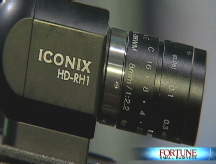Hollywood finds depth: 3-D boom
3-D films are making a comeback - aided by small companies with new technology that makes the pricey production process more affordable.
LAS VEGAS (FORTUNE Small Business) -- Hollywood is done with being shallow; it wants depth. 3-D depth, to be specific.
3-D filmmaking - the process of mounting two simultaneously filming cameras side-by-side and then superimposing the images on top of each other to create the illusion of depth - is looking at a comeback. At the recent National Association of Broadcasters show in Last Vegas, everyone from the major film studios to music-video production companies to the National Basketball Association displayed eye-popping examples of films and clips capturing artificial depth. Silly 3-D glasses were actually kind of hip over in the high desert.
The technology is far from new. 3-D was first tried in the 1950s, and later popped up in horror films starring Vincent Price. Even auteur Andy Warhol tried his hand at the tools. But filming even brief segments with two cameras was cumbersome and expensive; the cost of shooting an entire 3-D film was prohibitive for most projects.
But now, the alchemic effects of digital technology and the Internet are changing the business of adding dimensions. Miley Cyrus and U2 have put out successful 3-D films; kids love 'em. Big-name directors including James Cameron have 3-D projects in the works - the hot rumor in Hollywood is that George Lucas is working to re-release the entire Star Wars saga in 3-D.
The good news for small businesses is that the field is ripe with growing companies developing innovative solutions for 3-D's many challenges. Take Iconix Video Inc. in Goleta, Calif. It has created a nifty, super-small, high-definition imaging system that's going great guns in 3-D.
Company founder Wayne Upton, a video engineer with a background in medical imaging, got the idea for the technology while on assignment with a large Japanese electronics maker in 2003. The company asked him to solve a problem with a high-definition camera. Upton found a solution in about 48 hours, and was so taken by his idea that he decided to start a company based on the discovery.
Starting with a $1.2 million investment from venture-capital fund DFJ Frontier and others, Upton and his small company went into production with a high-def camera no bigger than an egg. The unit quickly racked up $1 million in sales based solely on word of mouth. It's easy to see why: The Iconix camera can be mounted just about anywhere - the side of a car, the end of a pool cue - to get once-impossible shots.
Upton's 28-person company has craftily partnered with other small businesses to expand its product line. It uses a clever two-camera mount from Israeli 3-D firm 3ality that lets directors precisely calibrate the crucial distance between the cameras. Iconix then uses off-the-shelf hard drives for storage and third-party post-production software to essentially create a complete 3-D system for little up-front investment.
"We believe it is the first end-to-end 3-D production environment that is within reach of just about any professional production company," said Bruce Long, Iconix's CEO.
Image quality in my limited demos was serviceable. A shot from a soaring glider, a flyover of a tropical island, and even a test section from the original Star Wars showed reasonable depth and none of the attendant disorientation - and often, motion sickness - common with 3-D.
But let's be clear here: The technology is no IMAX. The illusion of immersion is much more advanced in other systems. The technology favored by James Cameron, which was developed by cinematographer Vincent Pace, offers significantly more depth and higher image quality, to my eye.
But it's hard to argue with the price. Iconix cameras start at just $6,000 - way less than a tenth the cost of traditional HD cameras, which can run six figures or more.
With Hollywood facing stiff new competition from video games and other formats, hype about 3-D ran deep at the NAB show. Iconix's executives bullishly predicted that within the next few years, at least 30% of movies would be shot in 3-D.
But others, myself included, have more modest expectations.
"I think the hurdle that filmmakers face - and what will always keep this a niche technology - is that it is by definition cumbersome to shoot, even though great lengths have been made to simplify it, " said Doug Liman, a Hollywood director and producer whose credits include Swingers, The Bourne Identity and Mr. and Mrs. Smith.
But despite the limitations, even Lyman believes that this time, 3-D is here to stay.
"I do think it will be part of our moviegoing experience in the future," he said, "and we will have one to two 3-D films at the multiplex at any given time." ![]()
A Hollywood expat trains would-be Scorseses


